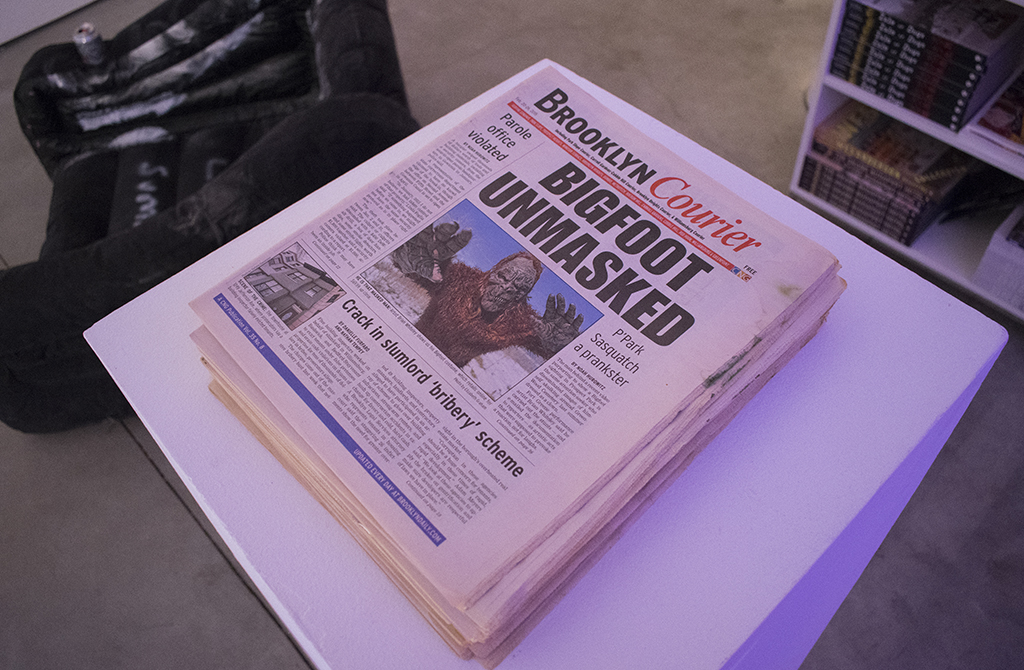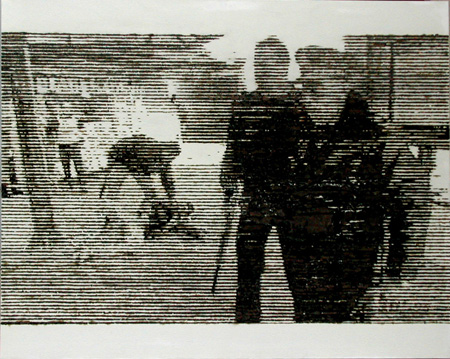Thoughts about Brian Whiteley’s Mid-Career Retrospective, “I Know What You Did Last Summer” Now on View at Hashimoto Contemporary
By Alexandra Goldman
Performance Artist Brian Whiteley’s bizarre multidisciplinary works come across as very genuine and lack self-consciousness. Whether it’s his performance, video, painting, sculpture or installation, Whiteley’s work is usually either highly politically charged, related to mortality, about clowns, or a combination of all three elements. When I walked into his mid-career retrospective at Hashimoto Contemporary earlier this month, I saw his highly publicized Trump-engraved tombstone, a very well done oil portrait of Vladimir Putin sitting in front of the White House in the style of a traditional U.S. presidential portrait, and a pair of giant, spinning conehead clowns/Lucha Libre fighters that looked like Nick Cave sculptures made out of craft materials from a party supply store. I’ve never been a fan of clown art, but it’s growing on me.

As one may be able to quickly recognize, Whiteley isn’t a fan of the 45th president, but his parents are. He told me that he’s had to seriously struggle with an irreconcilable divide in his nuclear family because of these differences of opinion. His isn’t the only family broken up by this highly polarizing situation.
As much as you don’t like someone, is it “wrong” to make a tombstone for them? After speaking with Whiteley about the project, I realized that his intention wasn’t a death wish, but rather a call for the President to recognize his own mortality. Whiteley told me that he had a personal moment canoeing upstate in which “a wave of intense thinking about his own mortality rushed over him,” after which the thought remained a bit obsessively on his mind. When he saw Trump campaigning for President in 2016, he perceived his attitude as one of immortality and a lack of awareness of how his actions affect others. That is why he had a real tombstone created engraved with the words “TRUMP, Made America Hate Again,” and anonymously abandoned it in Central Park leading to major controversy and his placement on the U.S. Secret Service watchlist. Whiteley is now permanently legally banned from attending any political rallies in the U.S.
I found that seeing a photo of the tombstone is much different than experiencing in person. When I saw a photo of it I thought, “ok, that’s cheeky, we all hate Trump, I get it.” But, when I was at the exhibition and felt the tombstone with my hand (you can touch it), I felt its weight (500 lbs to be exact) and gravity. It’s so stable and solid. It became clear that to have it made was a serious commitment. The tactile memory sucked me directly into a time tunnel and sent me straight back to the last time I touched my own grandparents’ tombstones in in Queens. It was the moment when I realized that what Brian had on display wasn’t a prop or a replica or joke of any kind, it’s the real thing and it’s creepy.
This also isn’t Whiteley’s only project related to mortality. He also dressed up as a clown, and paraded around a graveyard. When you get onto the homepage of his website, the cursor symbol is a hand holding a cigarette, in 2020, a well-known death wish of sorts. Not only that, but I immediately found the idea of a “Mid-Career Retrospective” to be morbid. For example the last couple retrospectives I saw at MoMA PS1… Vito Acconci…Carolee Schneemann…they both died within the year after their retrospectives ended. Calling his show a “Mid-Career Retrospective” immediately registered to me that Whiteley actively has his own lifespan on his mind.

Whiteley is a highly committed artist in general. That’s why I’m intrigued by his work. For example, not only is his relatively large presidential oil painting of Putin technically impressive (it is evident that he is a trained, talented figurative painter), but he then went the extra mile and utilized that painting – which is already intrinsically a work of conceptual art – for a high-risk performative action. While the painting is good, it doesn’t necessarily stand on its own, but the thing about Whiteley as an artist is I think he knew that, and he pushed himself to the limit. After completing the painting he stealthily hung it in the Pennsylvania Avenue suite of a Trump Hotel in Washington DC, where it remained on the wall for a full month without anyone noticing that it wasn’t a part of the intended hotel room decor.
With such a focus on politics and mortality in Brian’s work, I thought, where do clowns fit in? If his works aren’t physically depicting clowns, they are in a way all clown-like pranks. He’s the class clown and the world is his schoolhouse. We’re also now unfortunately used to the phrase, “The Clown in the Whitehouse,” or even regarding life in general, common phrases like “Man plans, God laughs” give some sort of hint that we’re all court jesters or buffoons here in one way or another. I did ask Whiteley on the phone, trying to hold back my own laughter, why clowns? And in a very clownlike fashion, he began the story as, “Well, when I was going through puberty, my parents sent me to summer camp…” But in all seriousness, he continued, “my parents were really hoping that at camp, I would choose activities like different team sports, but in reality I chose to sign up for art classes and clown class. I liked the way that being a clown allowed me to become a different character and play a role.”

Brian’s lifelong interest in clown work has manifested in even more of his diverse projects, including one in which he did extensive long-term research on believers in Bigfoot and Bigfoot sightings. He used his findings to accurately dress up and roleplay as Bigfoot roaming around Central Park, uncannily in character, contributing to more “sightings” and examining the Bigfoot myth. In his Mid-Career Retrospective, several of Whiteley’s small paintings and mixed media wall pieces based on clown imagery were also on display, along with his video “Clown’s Night Out II,” based on the artist’s imagined scenario of what a clown might do after a long day working kids’ birthday parties. His answer? The clown goes to a gogo bar with a male dancer (played by Whiteley). The awkwardly transfixing film was a big hit at the 2019 Spring Break art fair.
Speaking of art fairs, Whiteley also is the Founding Director of the Satellite Art Show, which I visited during Art Basel Miami week this year. Taking an anti-market stance in all that he does in the art world, Whiteley’s model of the Satellite Art Show is different from traditional commercial art fairs. Since its founding in 2015, Whiteley annually finds different affordable, nontraditional abandoned spaces like pharmacies or old shopping centers located in the vicinity of the main fair of a given city, and rents out booths to artists at very affordable rates that they can easily recuperate. For example, while a gallery may easily spend upwards of $30,000 on fair participation (with several thousand on just the booth rental alone), some of Whiteley’s booths have rented for only $700. Whiteley said that participants have been happy with their results and return on investment, including gallery representation and institutional acquisitions.

Whiteley intends for Satellite to provide an antidote to what he views as the market-tested, overly distilled art that is on view at main fairs due to galleries’ pressure to sell to make back the money invested (which he doesn’t blame them for). Whiteley is creating an alternative space to feature a plurality of emerging artistic voices that otherwise may not have the chance to be seen or heard during fair weeks, due to these financial realities that many people in the art world don’t want to admit are such a huge factor in what is seen and heard when it comes to contemporary art today, at least in the U.S. I have experienced that there is more room for this type of experimentation in Latin America where, for example, rent of space may be less astronomically priced. I was personally really interested in Satellite because it reminded me of certain great Latin American art spaces like Proyecto AMIL in Lima that traditionally has a big opening during the PARC and Art Lima fair week. The next activation of Satellite is set to take place in Austin, TX, March 13-16 in tandem with SXSW 2020.

Throughout all of Whiteley’s work both as an artist and Director of Satellite, his anti-market stance has not been immune to consistent pushback from institutions, fairs, and galleries. When he created the Trump tombstone in 2016 while Trump was on the campaign trail, the Queens Museum was interested in acquiring the piece for their sculpture garden. When Trump was actually elected that fall, the museum dropped the acquisition because, Whiteley believes, when it became real that Trump was President, the piece became too potentially controversial to certain major museum financial donors of theirs who may support him. Another example is when in 2018, the Art Basel Miami main fair sent Whiteley a cease and desist letter in response to his use hashtag “#NotBasel” to describe the Satellite Art Show on social media. Their argument was that people might confuse it to think that Satellite is or is connected directly with the Basel fair somehow. However, Whiteley explained that the cease and desist was sent suspiciously in tandem with the main fair’s interest in adding more installation-based and experiential art to their own program, and Satellite was on the rise a growing threat. Because of that cease and desist letter, Satellite can no longer take place during Miami Art Week in South Beach, which is why Whiteley relocated the fair to Wynwood.

Finally, Whiteley even admitted that Hashimoto Contemporary told him that his mid-career retrospective could be a financial risk for them, since his pieces aren’t particularly what most galleries would deem sellable. However, I’m glad they hosted it, because Whiteley is an interesting artist, it’s a different kind of show for the Lower East Side, and if you haven’t seen it, I hope you catch the final day tomorrow, Saturday, February 1.
All images and videos featured in this article are courtesy of Brian Whiteley.



